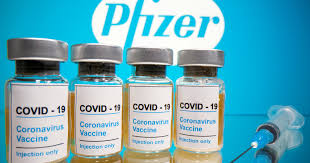It’s been a year of challenging questions posed by parents in my clinic trying to navigate the pandemic safely. But the one that’s become most common among them, as well as the public, is whether a COVID-19 vaccine will be safe and effective.
This vaccine is very important for the community to understand, especially with the government and CDC sort of saying “do it” to a general public that has lost trust in the system. So I’m diving in, hoping to help you understand more about mRNA, how it is being used in Pfizers’ vaccine and why the shot is effective. (Please see my disclaimer below as well.)
This may read like a biology lecture, but my fingers are crossed that it makes sense and helps you make informed choices.
Throughout a lifetime, cells continually divide for the purpose of growth and replacement of old, dead or damaged cells. A cell has two parts: the nucleus, a membrane-bound structure inside a cell that contains the cell’s chromosomes, and the cytoplasm, a thick solution composed of water, salts, and proteins enclosed by the cell membrane. In humans, the nucleus contains 46 chromosomes that code for the proteins necessary to survive and thrive.
Chromosomes are composed of DNA, a set of specific instructions—passed from parents to their offspring—which make all living things unique. Before a cell can divide, its DNA must be copied. While chromosomes and their DNA material reside inside the nucleus of the cell, copies are made on ribosomes, which are found outside the nucleus, floating in the cytoplasm. The copying process—known as transcription—requires messenger RNA (mRNA.) After copying a DNA strand inside the nucleus, mRNA migrates through a pore in the membrane of the nucleus and travels to a ribosome, where protein production—known as translation—begins.
Viruses hijack our body’s cellular processes to reproduce and spread. When COVID-19 finds the right cell, it injects a strand of RNA containing the genetic instructions for coronavirus, which are composed of 29 proteins. One protein—from which the coronaviruses derive their name—is the spike protein, a crownlike structure on the outer membrane surface. Spike proteins attach to specific cell receptors, known as the ACE2, similar to placing a key into a lock. After the virus can enter the cell, additional viral copies are made and then released into the body.
The Pfizer-BioNTech COVID-19 vaccine utilizes the virus’s genetic instructions for manufacturing the spike protein. Under normal circumstances, foreign mRNA injected into our body would be hacked to pieces by our immune system. In order to survive, the mRNA of the spike protein must be wrapped in a lipid particle for protection. This vaccine must also be transported at -94 degrees Fahrenheit because mRNA molecules degrade quickly at room temperature.
Once injected into the body, the lipid particles fuse to human cells and release the mRNA protein. The mRNA from the vaccine does not enter the cell nucleus and is eventually destroyed in the cytoplasm, leaving no permanent trace. However, the cell’s machinery makes new copies and builds spike proteins. These proteins do one of two things: they form protruding spike structures or break into smaller protein fragments. Then, the protruding spikes and protein fragments migrate to the cell surface and can be recognized by the immune system.
The immune system is too complex of a subject to cover in a single column. It is important to point out that a recent U.S. study found that infected people can and do generate COVID-specific T cells and B cells. B-cells fight viruses by making proteins called antibodies, which can recognize an invader, lock onto the cell surface, and mark it for destruction. T-cell responses likely play a valuable role in long-term immunity against COVID-19 because “killer” T-cells destroy infected cells, while “helper” T-cells stimulate B-cells to make antibodies. In addition, there are “memory” versions of B and T cells which remember infections and presumably fight them off better.
Now, let’s talk about what happens when the Pfizer vaccine is tested on real people.
It requires two shots, spaced 21 days apart, to generate adequate immune protection. 43,661 volunteers were divided into two groups: half received the “experimental” vaccine and the other half, a “placebo” version. Researchers waited until 170 people, going about their normal activities, tested positive for COVID-19. Out of those who contracted COVID-19, 162 received the placebo shot, while 8 received the experimental vaccine, yet still became infected. If a vaccine had 100% efficacy, no volunteers given experimental vaccine would get COVID-19. Since 8 did, efficacy is reported at 95%.
In reality, the world does not have the luxury of time on their side. When it comes to fighting COVID-19, the cost of certainty is far too great. There will be surprises along the way to vaccinating millions at risk. While no severe side effects were reported during the initial Pfizer phase III trial, the BBC has already reported two NHS workers with allergic reactions this past week. And the FDA is considering approval as I type this column.
If the FDA signs off on Pfizer’s crowning glory, that leaves every one of us with an important decision to make about our health and our lives. What will it be?
Disclaimer: This column is intended to assist readers with making an informed choice about whether or not to get the COVID-19 vaccine, when it becomes available. The information presented is not a product endorsement and is in no way intended to be a substitute for medical advice. I have no relationship with Pfizer, financially or professionally.
